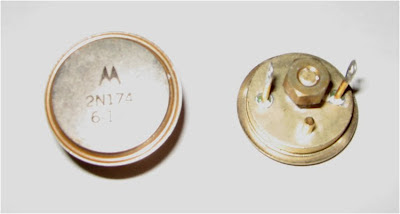We recently completed our “Test of Time” power supply
contest. Contestants told us about how they were using their Harrison Labs/HP/Agilent
DC power supplies and the older the power supply, the better. It was pretty
fascinating to see the many innovative way these power supplies were being
used. It was also fascinating to see so many “vintage” power supplies still functional
and in regular use after many decades. Several of them even being vacuum tube
based!
One key component found in most all power supplies from
the mid 1950s on is, no surprise, power transistors. Shortly after
manufacturers were able to make reliable and reasonably rugged transistors in
the mid 1950s they also developed transistors that would handle higher currents
and power. Along with higher power came the need to dissipate the power. This led
to some interesting packaging; some familiar and others not as familiar. Hunting
through my “archives” I managed to locate some early power transistors. In
review of their characteristics it was quite enlightening to see how they
evolved to become better, faster, and cheaper! I also found it is quite
challenging to find good, detailed, and most especially, non-conflicting
information on these early devices.
Germanium was the first semiconducting material widely adopted
for transistors, power and otherwise. One early power transistor I came across
was the 2N174, shown in Figure 1.
Figure 1: 2N174 Power Transistor
Following are some key maximum ratings on the 2N174 power
transistor:
- VCEO = -55V
- VCBO = -80V
- VEBO= -60V
- IC = 15A
- PD = 150W
- hfe= 25
- fT = 10 kHz
- Thermal resistance = 0.35 oC/W
- TJ= 100 oC
- Package: TO-36
- Polarity: PNP
- Material/process: Germanium alloy junction
The alloy junction process provided a reliable means to
mass produce transistors. Most of the earlier transistors are PNP with N type
semiconductor “pellets” or “dots” of typically indium alloyed to a P type germanium
wafer. This process favored PNP production as the indium had a lower melting
point than the N-type germanium bases. Still, this was a relatively slow and
expensive process as they were basically manufactured one at a time. These
early alloy junction transistors were not passivated and therefore needed to be
hermetically packaged to prevent contamination and degradation. Often referred
to as a “door knob” package, the TO-36 stud mount package was quite a piece of
work and was no doubt expensive to as a result. It had a pretty impressive
junction-to-case thermal resistance but given the maximum temperature of just
100 oC, low thermal resistance was necessary in order to operate the
transistor at a reasonable power level. The low maximum operating temperature
of germanium was one of most limiting attributes, especially for power
applications. The transition frequency, fT of just 10 kHz was also extremely
low. This is the frequency where current gain, hfe, drops down to 1, ceasing to
be an effective amplifier. The 2N174 appears to have originated in the later
1950’s.
Another early power transistor we used in our HP 855B
bench power supplies is the 2N1532, as shown in Figure 2.
Figure 2: 2N1532 power transistors used in a Harrison Labs
Model 855B power supply.
Following are some key maximum ratings on the 2N1532
power transistor:
- VCEO = -50V
- VCBO = -100V
- VEBO= -50V
- IC = 5A
- PD = 94W
- hfe= 20 to 40
- fT = 200 kHz
- Thermal resistance = 0.8 oC/W
- TJ= 100 oC
- Package: TO-3
- Polarity: PNP
- Material/process: Germanium alloy junction
The 2N1532 is also a germanium PNP power transistor,
similar to a number of other power transistors of the time. It is packaged in
the widely recognizable TO-3 diamond-shaped hermetic package. Being a much less complex case design it must
have been considerably less costly than the TO-36 package in Figure 1, and has become
one of the most ubiquitous hermetic power semiconductor packages of all times.
To keep junction temperature rise down the Harrison Labs Model 855B power supply used three 2N1532
transistors in its series regulator to deliver just 18 volts and 1.5 amps output. It’s no wonder
why these power supplies have stood the “Test of Time” as these transistors are
running significantly de-rated, at just a fraction of their maximum power here.
It is also noteworthy to see the
transition frequency of 200 kHz is 20 times that of the 2N174. This is one of
the more questionable data I had found but if it is accurate then clearly
design and process improvements contributed to this performance improvement. While date codes on some of the capacitors in
this model 855B power supply place its manufacture in 1962, early germanium PNP
power transistors in TO-3 packages like these also typically originate back in
the later 1950’s.

